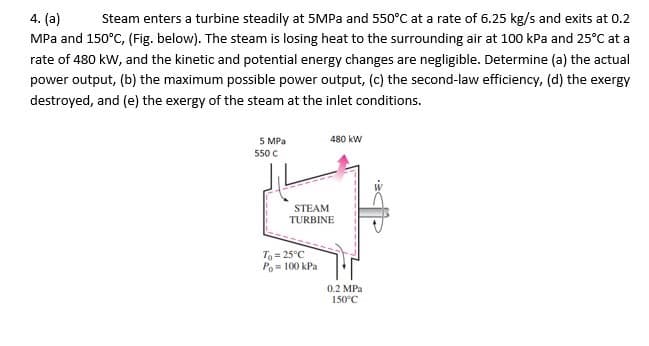4. (a) MPa and 150°C, (Fig. below). The steam is losing heat to the surrounding air at 100 kPa and 25°C at a rate of 480 kw, and the kinetic and potential energy changes are negligible. Determine (a) the actual power output, (b) the maximum possible power output, (c) the second-law efficiency, (d) the exergy destroyed, and (e) the exergy of the steam at the inlet conditions. Steam enters a turbine steadily at 5MPA and 550°C at a rate of 6.25 kg/s and exits at 0.2 5 MPa 480 kw 550 C STEAM TURBINE
4. (a) MPa and 150°C, (Fig. below). The steam is losing heat to the surrounding air at 100 kPa and 25°C at a rate of 480 kw, and the kinetic and potential energy changes are negligible. Determine (a) the actual power output, (b) the maximum possible power output, (c) the second-law efficiency, (d) the exergy destroyed, and (e) the exergy of the steam at the inlet conditions. Steam enters a turbine steadily at 5MPA and 550°C at a rate of 6.25 kg/s and exits at 0.2 5 MPa 480 kw 550 C STEAM TURBINE
Elements Of Electromagnetics
7th Edition
ISBN:9780190698614
Author:Sadiku, Matthew N. O.
Publisher:Sadiku, Matthew N. O.
ChapterMA: Math Assessment
Section: Chapter Questions
Problem 1.1MA
Related questions
Question
Please answer all what is asked or 3 subparts based on honor code.

Transcribed Image Text:4. (a)
Steam enters a turbine steadily at 5MPa and 550°C at a rate of 6.25 kg/s and exits at 0.2
MPa and 150°C, (Fig. below). The steam is losing heat to the surrounding air at 100 kPa and 25°C at a
rate of 480 kw, and the kinetic and potential energy changes are negligible. Determine (a) the actual
power output, (b) the maximum possible power output, (c) the second-law efficiency, (d) the exergy
destroyed, and (e) the exergy of the steam at the inlet conditions.
5 MPa
480 kW
550 C
STEAM
TURBINE
T= 25°C
Po= 100 kPa
0.2 MPa
150°C
Expert Solution
This question has been solved!
Explore an expertly crafted, step-by-step solution for a thorough understanding of key concepts.
Step by step
Solved in 3 steps

Knowledge Booster
Learn more about
Need a deep-dive on the concept behind this application? Look no further. Learn more about this topic, mechanical-engineering and related others by exploring similar questions and additional content below.Recommended textbooks for you

Elements Of Electromagnetics
Mechanical Engineering
ISBN:
9780190698614
Author:
Sadiku, Matthew N. O.
Publisher:
Oxford University Press

Mechanics of Materials (10th Edition)
Mechanical Engineering
ISBN:
9780134319650
Author:
Russell C. Hibbeler
Publisher:
PEARSON

Thermodynamics: An Engineering Approach
Mechanical Engineering
ISBN:
9781259822674
Author:
Yunus A. Cengel Dr., Michael A. Boles
Publisher:
McGraw-Hill Education

Elements Of Electromagnetics
Mechanical Engineering
ISBN:
9780190698614
Author:
Sadiku, Matthew N. O.
Publisher:
Oxford University Press

Mechanics of Materials (10th Edition)
Mechanical Engineering
ISBN:
9780134319650
Author:
Russell C. Hibbeler
Publisher:
PEARSON

Thermodynamics: An Engineering Approach
Mechanical Engineering
ISBN:
9781259822674
Author:
Yunus A. Cengel Dr., Michael A. Boles
Publisher:
McGraw-Hill Education

Control Systems Engineering
Mechanical Engineering
ISBN:
9781118170519
Author:
Norman S. Nise
Publisher:
WILEY

Mechanics of Materials (MindTap Course List)
Mechanical Engineering
ISBN:
9781337093347
Author:
Barry J. Goodno, James M. Gere
Publisher:
Cengage Learning

Engineering Mechanics: Statics
Mechanical Engineering
ISBN:
9781118807330
Author:
James L. Meriam, L. G. Kraige, J. N. Bolton
Publisher:
WILEY